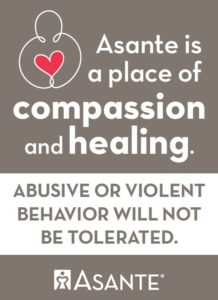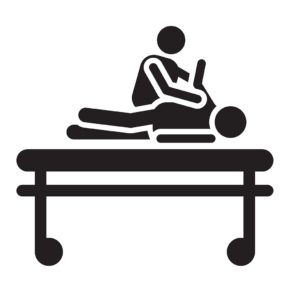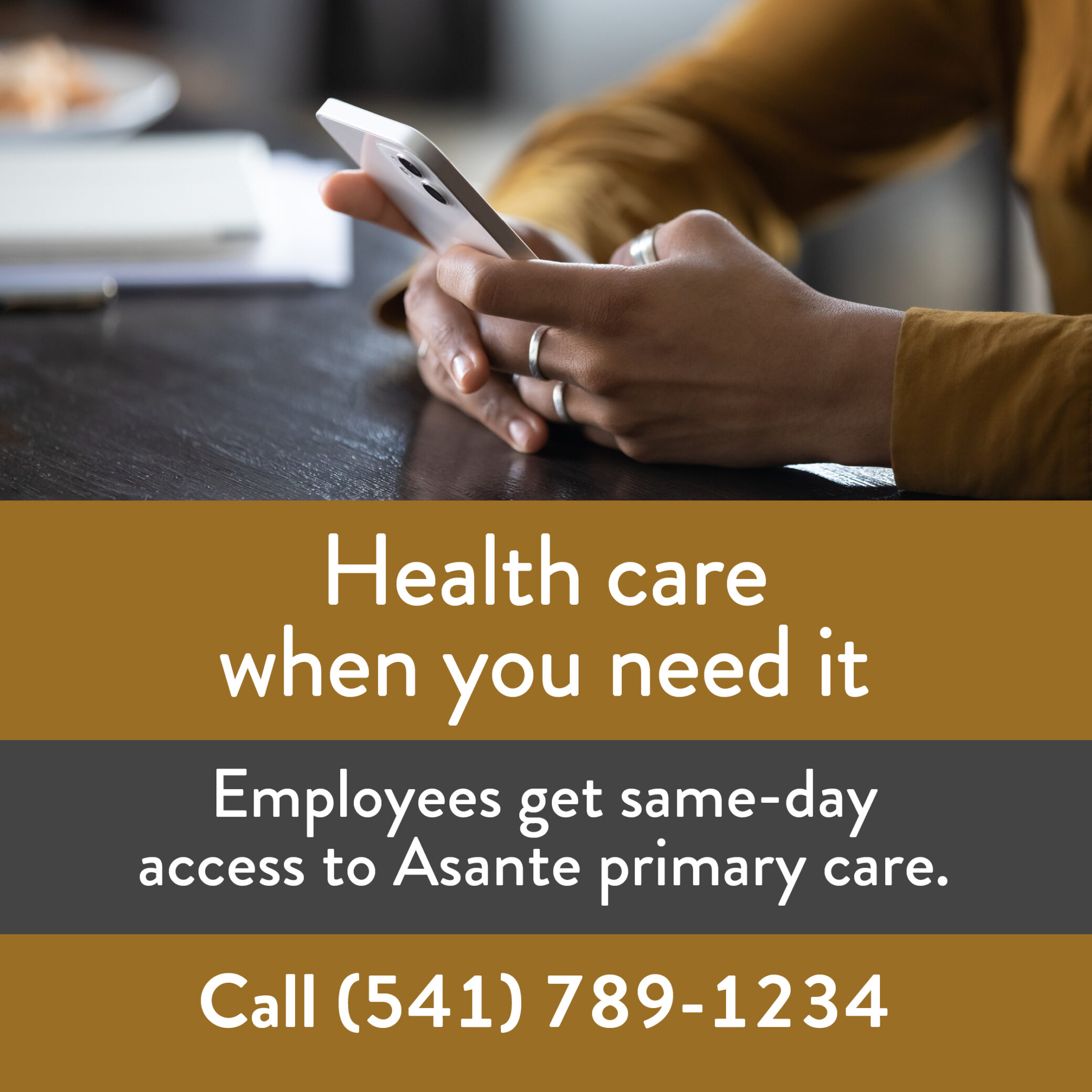Share:
In Massachusetts, a surgeon was shot and killed. In Louisiana, a nurse died while protecting a co-worker from a patient’s assault. In Minnesota, a nurse was attacked by a patient wielding a metal pipe.
Across the country and within Asante, health care workers are being assaulted physically and verbally, making workplace violence among the profession’s most pervasive — and underreported — threats. In fact, health care workers have a 20% greater chance of being assaulted than other workers.
Because of this, Asante is taking a bold stand against violence in our facilities, whether it’s committed by patients, visitors or even co-workers. Earlier this year, Asante established the Workplace Violence Prevention Council, a 30-member group with representatives from various jobs and departments throughout the organization. The council’s aim is to stop violence in our facilities.

As the first publicly visible results of the team’s work, signs will appear in Asante hospitals later this month reminding all who enter our buildings that any form of violence is not tolerated.
The signs will be posted in areas with the greatest risk of violence against staff, including the Emergency Department and registration desks.
“We want our patients and visitors to know that we expect them to treat their caregivers with the respect we give them,” said Robert Begg, vice president of Human Resources. “Having a visible message that spells this out is the first step, with additional patient education to follow.”
The signs are just the beginning of the team’s work, which focuses on raising awareness; strengthening incident reporting; educating employees on how to prevent violence and protect themselves; updating policies and creating a physical environment that reduces risk of violence against staff.
The project relies on a variety of tools to reduce violence, including the Oregon Association of Hospital and Health Systems’ 172-page Stop Violence in Healthcare toolkit, which was developed by several professional organizations, including the Oregon Nurses Association.
“Lynda Enos, RN, known by many at Asante for her work assisting us with our safe patient handling initiatives, is the primary author of this extensive document,” said Karey Westbrook, who leads Asante’s Workplace Violence Prevention program along with Neff Clark. “It references the vast amount of literature that has been written from studies on this topic across the U.S. and internationally and uses that to provide recommendations for implementing a successful workplace violence prevention program.”
“We are looking at Asante’s Workplace Violence Prevention program from start to finish, closing any gaps to make our facilities as safe as can be,” Clark said.
Over the next several months, the team will offer tips on preventing workplace violence, deescalating tense encounters, developing personal resilience and more in Asante News.
The ultimate goal is to change Asante’s culture.
“The safety of our employees is as important as the safety of our patients; becoming the victim of violent or assaultive behaviors should never be written off as part of the job,” said Laura Magstadt, vice president of Nursing at Asante Three Rivers Medical Center and co-executive sponsor of the Workplace Violence Prevention Program. “It is critically important that incidents of workplace violence come out into the open so we can learn from them and do the work that is necessary to end violence and abuse toward our employees.”

Stories from the front lines
“I once had an interaction with a patient who had a history of schizophrenia and needed placement but had not been medically cleared. He was in IMCU with a sitter (a CNA who was pregnant). As I walked by the room I noted he was starting to get agitated. He had been helped to the restroom in the back and, for no discernible reason, had started engaging in self talk that gradually increased in intensity.
“I stepped in to check on the sitter and the next thing I knew he had ripped the toilet privacy curtain down and was walking towards me with it held high like he was going to bring it down over my head. This was unnerving as he was over 6’5” tall. I believe I called for help or perhaps the CNA. I remember holding up my hands to prevent the curtain from coming down over my head when a male CNA and RN arrived. They secured the patient’s arms, but my hand was pinned between them.
“The patient was not specifically fighting us, but some internal battle, and was only responding to commands intermittently. Eventually I was able to remove my hand and we maneuvered the patient to the bed where he knelt down and began praying. I think we ended up placing soft wrist restraints and possibly administering some medications. My hand was bruised slightly, but otherwise, no one was harmed.”
Tonsina Wells, RN, ARRMC critical care nursing resource team
Have you been subject to verbal or physical abuse on the job? Share your story at as********@as****.org.
If you have a question, please contact the author or relevant department directly.




5 Comments. Leave new
Such important work! Thank you for caring for the caregivers and frontline healthcare workers!
I was an ER nurse in another facility. We had a combative young female that had emotional problems and was awaiting labs we already had security in the room and a city police officer. I had escorted her to the BR and when entering the room again with her she suddenly turned, grabbed me by the throat and pinned me against the wall. I had a hold of one of her hands, but she had my throat. Thankfully the security people were able to get her to let go of me and she was placed in restraints. I had bruising on my neck and probably shook for an hour afterward.
The committee may be interested in: [PDF]
The Ramsey County Initiative for Violence Free Families …
https://www.ramseycounty.us/sites/default/files…
I volunteered from 1992 – 2005 on the Workplace Action Team in St. Paul Minnesota. They addressed workplace violence in a number of settings including Healthcare and also the spilling over of domestic violence into the workplace. They have a large amount of data and information as they had about a dozen action teams for different aspects of the community. Of chief importance was the defining of violence:
“The Initiative uses two definitions of violence which guide our efforts in developing and implementing violence prevention strategies.
1. Violence Is A Misuse of Power and Authority
2. Violence Is Words and Actions That Hurt People
I was an RN in a 40 bed psych unit at a California hospital. One night a patient in the secure “lock down” area was starting to make demands and yell. I had a good rapport with him, and thought I could deescalate him and offer medication. I went into the locked dining area with him, while another staff member watched us on camera. There wasn’t enough staff for someone to go in with me, and I didn’t think I needed security based on my rapport and past experience with the patient who had never assaulted anyone previously – plus my judgement that his agitation was in the early stages. Once I got into the locked area, things went south VERY quickly. He went from early signs of agitation to a full blown rage within 30 seconds. It was like he became “the incredible Hulk.” He picked up a “psych safe” table (i.e. too heavy to lift) with 4 chairs attached to it by metal bars and pinned me up against the wall with it. The attached chairs were swinging wildly on either side of me, and he was leaning his weight into the table to pin me to the wall, while threatening to harm me if I didn’t let him out. He was a good 100 lbs heavier than me and well over a foot taller. None of the staff came in to assist, but I heard a “code green” (the old term for a code gray) called. It took over a minute for help to arrive, during which time I thought he was going to kill me. I kept hearing “help’s on the way” over the intercom. I had broken out in hives and was itching everywhere — and then I had a bronchospasm and started to wheeze – all while still pinned against the wall. When help arrived, they were afraid to taze him and have the table fall on him or me, but enough people were able to take him down and I slid away and out of the area to safety. I had to go to the ED for an epinephrine shot and nebulizer treatment. Because we were short staffed and it was night shift around 2 am, I returned to the psych unit to finish my shift with the ED doc’s reluctant approval — once my heart rate returned to normal, and the itching was under control. It took awhile for the hives to go away and I was on hydroxyzine for a few days to help with that. The next morning the psychiatrist decided the patient wasn’t psychotic but was merely displaying antisocial behavior, so he discharged him to the street. I never pressed charges, and there was never any follow-up provided for me regarding the incident and it’s impact.
Before working for Asante, I used to work in a nursing home here in Grants Pass whom the facility’s name I will not mention. One afternoon, I was assigned to care for an elderly man that used to be in the Navy. I was giving him shower and suddenly he hit me very hard with the shower sprayer (which is made of stainless steel) in the forehead and he followed it with a statement of “I hate Filipinos” then spat on the floor in front of me; and yes I’m a Filipino. After dressing the patient and returning him to his room, I reported the incident to my charge nurse and requested not have him under my care again. I was expecting for my simple request to be granted but to my surprise I was assigned to the same patient, but to no one’s surprise, I was assaulted by the same patient once more. I felt that my voice fell into deaf ears, but I have forgiven the patient, manager and charge nurse, but I will never forget. I’m now an employee of TRMC Asante for 4 years and I have encountered multiple racist patients calling me Chinese or Mexican and saying nasty things to me. Every time I have such patients, I request my charge nurse not to have them under my care and my charge nurse grants it and I appreciate it because I feel that I am respected as an individual. Every form of abuse be it physical, mental, or emotional should not be tolerated in this field or any other field. We pour sweat, time, effort, and sanity to take care of fellow human beings and we should be appreciated because we are the ones tending to them on times that they cannot look after for themselves.